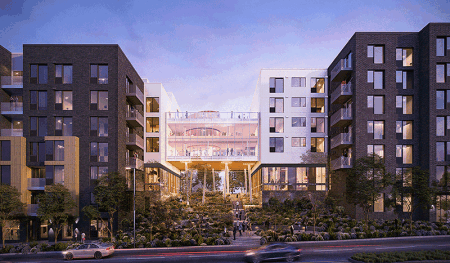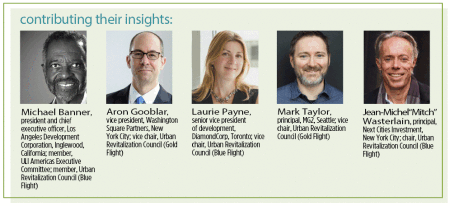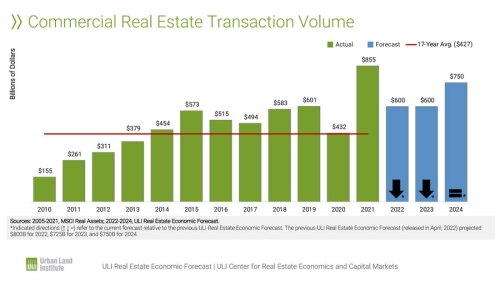
Mall transformation: 60 years after Northgate Mall opened nine miles (14.5 km) north of downtown Seattle, Simon Property Group is redeveloping it into an urban mixed-use environment with retail, office, hotel, residential, and recreational uses that include a network of new streets, pedestrian corridors, and a central park.
How can urban cores rebound from the COVID-19 pandemic?
Members of ULI’s Urban Revitalization councils discuss the pandemic’s potential long-term effects on development in urban cores, opportunities for creative redevelopment, steps that municipalities can take, ways to enhance resilience in urban cores, and other trends.
What lasting effects do you think the pandemic will have on development in urban cores?
Mark Taylor: The pandemic has resulted in a reclaiming of public spaces and a broader understanding of all the possibilities of our public rights-of-way. They can be used not just for cars, but for all modes of transportation, as well as for community-oriented activities. Healthy streets initiatives all over the world have gotten a lot of press. It has been fun to see how quickly outdoor dining shelters have gone up on sidewalks, but of course, there are safety concerns and other issues we need to address. New York City has closed down entire streets to vehicle traffic, creating zones where restaurants can spill out, and that idea has real staying power.
Aron Gooblar: Everyone is watching to see how the return to offices will go because through the pandemic, so many employees worked from home. Now companies that didn’t need to be in urban cores are reconsidering the higher occupancy costs of being there and moving to a more decentralized model. That underscores the importance of creating mixed-use neighborhoods. A healthy urban core needs neighborhoods where people want to live and work and just hang out. We will see opportunities for new residential developments in office districts and hopefully some conversions of older, obsolete office buildings into housing.
Laurie Payne: In Toronto, we have been in lockdown for the better part of a year, and now that we’re finally allowed out, public space has taken on an entirely new meaning. All the institutions that were preventing progressive change have found a way to make it happen. For example, the Liquor Control Board and municipalities now allow beer to be sold on the streets. There is a new respect for public space and a new creativity. However, the central business districts and financial districts are going to acutely feel the pain because they are monocultures of office and retail. They are lacking public spaces, residents, and schools. Those places that didn’t have good public spaces and good urban design need to be repaired.
Michael Banner: Some corridors here in Los Angeles might have stalled because of the pandemic, but development will continue, although possibly at a slower pace than before. But there are urban corridors that have struggled to attract capital for the last 40 or 50 years, having faced many problems, from fires to riots to earthquakes to the pandemic. Now there is greater interest to invest in these overlooked communities. However, these communities have been caught in the same disinvestment cycle for decades, so it will be important for investors and policymakers to stay focused and patient if they really want to change outcomes.
Mitch Wasterlain: Downtowns will remain strong and compelling places to live. However, I see a shift from gateway cities like New York City and San Francisco and Los Angeles to cities that still have appealing urban density but are more affordable and have a less stressful lifestyle. Second-tier cities like those in the Sun Belt are getting a lot of attention, but many industrial cities in the Northeast and Midwest are also experiencing rebounds. They tend to be relatively affordable, they have good infrastructure, they have cool older buildings that can be renovated, and they have an urban feel. People still want walkable places.
What opportunities for creative redevelopment are you seeing?
Payne: Retail is probably not coming back the way it was. No one has had time yet to think about what we do with all those vacant spaces. Do they become community spaces? Coworking facilities? They are fantastic redevelopment sites. Hopefully, new development will add population density that strengthens the retail sector overall. There has been a positive shift toward cycling here in Toronto and I’m sure elsewhere as well. Every day, new cycling infrastructure is being installed. There used to be a lot of tension between communities because of fears over slowing traffic, but now there is a new appreciation for cycling.
Taylor: At the ULI Fall Meeting [of 2020], we were talking about the importance of arterial roads that feed the urban core, and considering opportunities to reimagine them from a transit perspective and add housing so more people can afford to live close to the urban core. As retail continues to change, strip malls and other shopping centers near the urban core are becoming almost satellites of downtowns. In Seattle, one example is Northgate Mall, a traditional mall with anchors at each end and shops in between, which has been completely transformed. Its parking lots are being filled in with multifamily residences, offices, a hotel, and a hockey training ice rink complex. A new light-rail station is about to open that will allow people to get from there to the downtown core quickly.
Wasterlain: Older industrial and office buildings present a lot of opportunity for adaptive reuse. Re-developing them can also offer the chance to integrate office and residential uses. For one development we’re about to get started on we’re placing small loft-type office suites for entrepreneurial tenants on the ground floor and apartments on the upper floors. Office and apartment tenants will have the same access to shared amenities, like a conference room and “Zoom rooms” for individual use. So someone working from home can rent these spaces by the hour or the day if they have kids running around the house or just don’t want to work in their kitchen. I think more developers will be testing out concepts like this.
What steps should municipalities be taking to help urban cores recover?
Banner: Municipalities that have been under financial duress themselves may not have a lot of resources to bring to the table. But municipalities can pull together an array of financial and regulatory incentives to create a supportive ecosystem where equitable development can occur. They can play the role of conductor and change people’s perceptions about what is possible. While the final form of massive levels of federal funding is still being worked out, it is clear there will be more resources available, and governors in concert with local jurisdictions will be making decisions about how best to orchestrate delivery of these dollars. Turning those resources into predictable and equitable outcomes will come down to leadership. A municipality that finds a way to leverage some of its own resources to attract federal funds will be more likely to attract development interest. I believe smaller cities have an advantage over larger cities if they make decisions quickly.
Wasterlain: The infrastructure package that Congress is working out will be of huge importance to cities. And I believe infrastructure should be defined broadly: It’s not only about roads and public transportation, but also about all the things that make it more feasible for people to work and live. That can mean everything from providing daycare centers to repurposing streets to create more pedestrian-oriented areas. It’s all the more important these days for cities to make attractive environments for people and to eliminate some of the friction of city life—for example, the tension between all the different modes of transportation, from cars and buses to bikes.
Gooblar: Cities like San Francisco, Los Angeles, and New York City allowed more outdoor dining. It’s important for that trend to continue to bring vitality to the streets and help restaurants to recover as indoor dining opens up. This is also a good moment for municipalities to take a look at zoning rules and consider if it still makes sense as we come out of the pandemic. Converting office buildings to residential use is a potentially good opportunity, but the codes don’t allow it in many places—certainly not in New York City. Also, developers are required to build ground-floor retail space in many districts, but it’s important to ask if there is enough demand to support it and how it might impact retail spaces that are already there.
Payne: Remove red tape: get building happening as quickly as possible because that generates revenue and it gets people spending. Here in Toronto, construction is one of the number one employers, and it’s a job that pays well. If we accelerate as quickly as we can into recovery, the urban ecosystem will repair itself. But if we get too fearful or go too heavy on the cost-cutting, that will slow down the repairing.
Taylor: In cities like Seattle and San Francisco, homelessness continues to be a major issue. Housing is the biggest factor to address to help our urban cores recover. Municipalities need to encourage housing development at all price levels, from affordable to market rate. They can make permitting and entitlement processes easier so we can get housing onto the market more quickly.
What kinds of investment could help prepare urban cores to be more resilient in the face of adverse events like the pandemic?
Gooblar: We learned in the pandemic that one of the greatest strengths of cities—density—can also be a liability in a health crisis. Those who could afford to fled dense urban areas, and those who couldn’t were left behind. So it’s time to pay more attention to parks and open space—to consider how they are being operated and where there might be opportunities to add more to increase social equity. The rates of infection and mortality in the neighborhoods most affected by the coronavirus are completely unacceptable.
Payne: We can prepare by focusing on the human element—making sure we have structures in place to protect the most vulnerable. Human ingenuity and resilience got us through this pandemic and will get us through the next challenge.
What other trends are important to pay attention to?
Wasterlain: Everybody was surprised that the pandemic caused a housing boom. In some ways, this has exacerbated the affordability crisis in many cities, and it’s something that we need to address. A lot of real estate, including old retail centers, needs to be repurposed as housing and mixed-use properties. Closely related is the issue of racial equity. The systemic biases in the housing market have existed for a long time. We need to reverse those and give everyone a fair shot at housing they can afford.
Banner: Higher-income communities have always been able to articulate their wants, needs, likes, and dislikes. But over the last decade, lower-income communities, which have experienced disinvestment, have upped their game in that respect. The greater availability of data allows these communities to access the same data sets that in the past only a large think tank might have. Along with the increase in community organizing, more banks, public companies, and other anchor institutions are adopting environmental, social, and governance [ESG] mandates. I believe it is important to announce aspirational goals to invest more into low-wealth neighborhoods, but now organizations must develop stakeholder tools to measure their results to determine whether they’ve accomplished what they’ve set out to do.
Gooblar: I live in New Jersey, which is known for its malls, and what has surprised me is how quickly consumers have returned to brick-and-mortar shopping. Early in the pandemic, you couldn’t go two days without reading a story about the final death of retail. It’s clear that retail is evolving, but people don’t want to do all their shopping online, especially after having no other options for months. I think we’ll see interesting opportunities for new retailers and restaurateurs.
Payne: Immigration is massively important to the growth of our cities. Around the world, governments have been very nationalistic because of the pandemic, but as that opens up, I think we will see a lot of positive change. I hope that governments and society embrace it because it will be a big part of the recovery, at least here in Canada.
Taylor: At this point in the pandemic, more people are vaccinated and everyone is becoming more accustomed to being among other people. But there are still moments when we walk up to an elevator and decide it looks a little packed, so we wait for the next one. Are we ready to go back to small music venues? How comfortable are we to walk up to somebody who’s not masked or walk into a crowd of people? As quickly as we went into quarantine, it’s going to be different coming out of it. It will take a while for everybody’s comfort level to come back.
RON NYREN is a freelance architecture, urban planning, and real estate writer based in the San Francisco Bay area.




